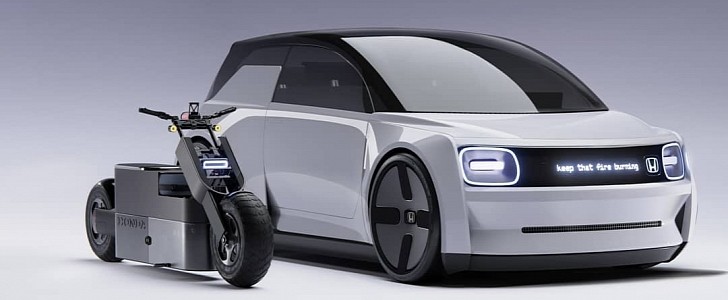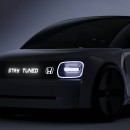The original Honda City is one of those weird Japanese models that not everyone knows about, and there are several factors responsible for that.
For one thing, it was mainly built for the manufacturer's domestic market, something plainly obvious from its design and, even more so, from its dimensions. The City was also imported in Europe but under the Jazz name, a moniker that's still in use for the smallest member of Honda's range to this day.
The first City wasn't tiny enough to fall under the Japanese Kei-car regulations, but it wasn't big enough to be taken seriously elsewhere either. However, thanks to its "Tallboy" design (the name says it all), it was able to fit four people while maintaining a very small footprint.
The coolest thing about the City, though, was actually a completely different vehicle, if that makes any sense (it will in a minute). Honda came up with the Motocompo, a 50-cc foldable scooter that could fit in the City's trunk and help the driver move more quickly through a busy city center or through an area with restricted car access.
Considering the City was introduced nearly 40 years ago, the whole idea seems way ahead of its time. These days, though, when "last-mile" transportation has become a thing, something similar would surely make a lot of people happy.
That's what a group of three Russian designers from Moscow thought when they came up with this Honda City revival project. Surprising absolutely no one, their modern take on both the car and the scooter uses battery power, making the City not just smart transportation but also zero-emissions transportation.
The public for small electric cars is generally believed to be living in the city. Ironically enough, given the name, the City's concept enables suburban dwellers to use it as well. They can drive the EV to a car park fitted with lots of charging stations inside the city, leave it there to charge while they're at work, and take out the electric Motocompo for that generic last mile to their office. It's an integrated all-electric transportation solution that's been proven to work (some people are already doing it).
Design-wise, the all-new Honda City benefits from the release of the Honda e. It's not a copy of the diminutive Japanese EV, but rather an obvious family member. It appears to be slightly larger than Honda's actual EV, and despite maintaining a friendly appearance, it's not as comical as the e.
Much like the e, we doubt the City would be a great commercial success for Honda. After all, you can buy any other EV and any other foldable electric scooter and have a similar package, more tailored to your needs. As a statement, though, it would put Honda in a strong position. The Japanese company could say, "Hey, everybody, we've been doing this since 1981."
The first City wasn't tiny enough to fall under the Japanese Kei-car regulations, but it wasn't big enough to be taken seriously elsewhere either. However, thanks to its "Tallboy" design (the name says it all), it was able to fit four people while maintaining a very small footprint.
The coolest thing about the City, though, was actually a completely different vehicle, if that makes any sense (it will in a minute). Honda came up with the Motocompo, a 50-cc foldable scooter that could fit in the City's trunk and help the driver move more quickly through a busy city center or through an area with restricted car access.
Considering the City was introduced nearly 40 years ago, the whole idea seems way ahead of its time. These days, though, when "last-mile" transportation has become a thing, something similar would surely make a lot of people happy.
That's what a group of three Russian designers from Moscow thought when they came up with this Honda City revival project. Surprising absolutely no one, their modern take on both the car and the scooter uses battery power, making the City not just smart transportation but also zero-emissions transportation.
The public for small electric cars is generally believed to be living in the city. Ironically enough, given the name, the City's concept enables suburban dwellers to use it as well. They can drive the EV to a car park fitted with lots of charging stations inside the city, leave it there to charge while they're at work, and take out the electric Motocompo for that generic last mile to their office. It's an integrated all-electric transportation solution that's been proven to work (some people are already doing it).
Design-wise, the all-new Honda City benefits from the release of the Honda e. It's not a copy of the diminutive Japanese EV, but rather an obvious family member. It appears to be slightly larger than Honda's actual EV, and despite maintaining a friendly appearance, it's not as comical as the e.
Much like the e, we doubt the City would be a great commercial success for Honda. After all, you can buy any other EV and any other foldable electric scooter and have a similar package, more tailored to your needs. As a statement, though, it would put Honda in a strong position. The Japanese company could say, "Hey, everybody, we've been doing this since 1981."














